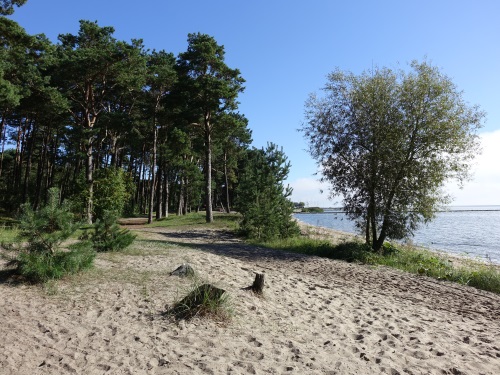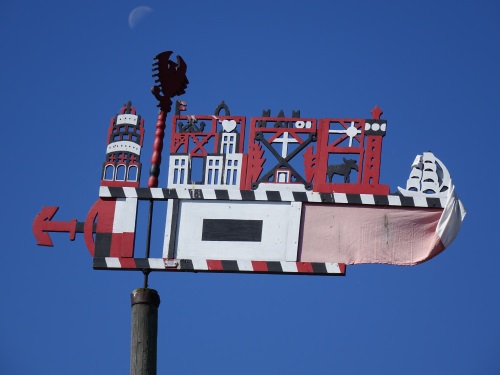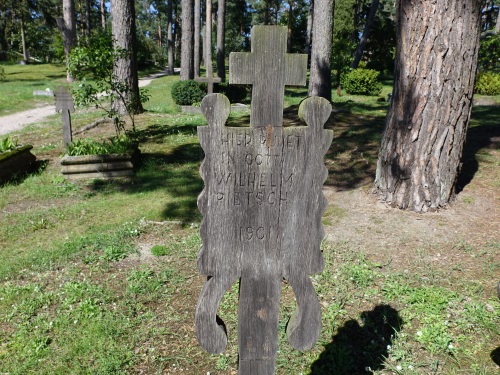The
Curonian Spit always has been a bit of an enigma to me. Who were these Curonians? And what is a Spit anyway? The Dutch translation (‘Schoorwal’) did not really help me as it is also a very uncommon word, used primarily to adress the Curonian Spit. So I was happy that we decided to have our WH meeting in Vilnius this year: with a few extra days I could check out this WHS too. I stayed for two nights in Klaipéda, the easiest access point to the Lithuanian part of the Curonian Spit.
 |
| The forest almost reaches the beach |
Besides its name, another part of the site’s mystery is why it was designated a WHS. It was put forward under 7 natural and cultural criteria. But in the end it was only recognized for one: the efforts, started by the Prussians in the 19th century and continued by the Lithuanian and Russian authorities after WWII, to save this sand dune peninsula from erosion. Constantly moving sand dunes even had made whole villages disappear. Large-scale (re)afforestation was started to keep the sand in place.
Forest still is one of its main features: my first impression of the peninsula was driving by bus from Smitylne to Nida. Especially the first half hour or so goes on a narrow road through a dense forest. The Lithuanian road ends after 50km in the town of Nida, close to the Russian border which unfortunately cannot be crossed easily (one needs a Russian visa and a mode of transport). Nida is the site of the Spit’s no. 1 landmark: the Parnidis Dune. That’s where I headed for my first hour of exploration.
 |
| Curonian weathervane |
It’s a fine walk, with the bonus of a bit of warm sand between your toes. The scenery reminded me of the islands in the Dutch part of the
Wadden Sea, the most comparable WHS to this one. The Curonian Spit also shares the nuisance of high visitor numbers in a relatively confined space with it. Lots of families with young children were trodding along on the interpretative trail to the Parnidis Dune. And at the top it got even worse: there is a bus parking at the back. Literally hundreds of cruise ship passengers are offloaded from their buses all day long, to be allowed a glimpse of this work of nature too.
Back in the village of Nida I visited an old fisherman’s house. It is a reminder of the life of the Curonians, who lived in this region until they merged with other Baltic tribes in the 16th century. Via a video display you can witness the last two men speaking the now extinct Curonian language. Next to the house is an exhibition of colourful Curonian weathervanes. Sculpted from wood, they were not only useful for the sailors to see which way the wind was blowing but also indicated the people ashore from which hamlet they came.
For lunch I had put my sights on the local specialty: smoked fish. For 5 EUR I got a large smoked mackerel on a paper plate, which I enjoyed dissecting. With this boost of energy I walked to the other end of Nida, where I had a look at the old cemetery. The graves here are specifically mentioned in the AB evaluation, so this is an aspect not to be missed. The gravemarkers are cut from timber into designs of flowers or human silhouettes. It’s not exactly that the cemetery is full of them, but I found a few.
 |
| Nida cemetery |
On my way back to the ferry to Klaipéda I made stop in Juodkranté, the second most important town of the peninsula. It is a historic seaside resort, with lots of early 20th century wooden villas. It also is home to the 'Hill of Witches', where artists have shown their woodcarving skills via timber sculptures depicting local legends. It's a bit of a tourist trap, but some are nicely done and it is a fine short hike through yet another part of the forest.
So that's what I grasped from my day trip to the Lithuanian part of the Curonian Spit. I'd love to see a review featuring the Russian side.